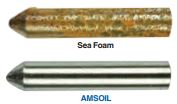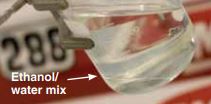Small engine won’t start?
Bad gas is the number-one reason, and here’s how to prevent it.
Len Groom | TECHNICAL PRODUCT MANAGER, POWERSPORTS
In northern Minnesota, where I live, the temperature occasionally breaks 80ºF (27ºC) in the summer. When it does, it’s time to fire up my Jet-Skis* and hit the lake. The last thing I want to do on a sunny summer day is mess around with equipment that refuses to start or run properly.
Bad gasoline is the number-one reason seasonal equipment starts hard or runs rough. Over time, gasoline changes, leaving behind gums, varnish and other solids that foul the fuel system and prevent gas from flowing into the combustion chamber. In severe cases, gasoline can change so dramatically that it no longer ignites.
Gasoline is predominantly a mixture of carbon and hydrogen atoms bonded together into energy-dense hydrocarbons. Like conventional base oils, it’s derived from crude oil via a distillation process that uses heat, pressure and other catalysts to create different fractions. Gasoline is comprised of hydrocarbons that are lighter than those found in, for example, diesel fuel or conventional base oils. Refiners add ethanol to the formulation, typically 10 percent, but as high as 85 percent.
Time Takes Its Toll – You Must Treat Gasoline
Time, however, takes its toll on gasoline. Exposure to heat, humidity, atmospheric pressure, oxygen and other variables degrade fuel.
In addition to gums and varnish becoming more concentrated and less soluble as lighter hydrocarbons evaporate, gas is continually oxidizing, which further contributes to varnish and other gunk. Gasoline oxidizes more quickly than motor oil and its negative effects are more immediately noticeable. That’s why it’s important to use high quality gas and store it in approved containers where air infiltration is limited, like inside a ventilated garage or shed, and not in the back of your truck or under the deck.
Meanwhile, ethanol added to gasoline at the refinery can absorb water from the atmosphere, which can lead to phase separation, which occurs when ethanol and gas separate, much like oil and water. Ethanol that has absorbed enough moisture and has sat long enough can foul the fuel system and prevent the engine from starting.
AMSOIL Fights Corrosion
AMSOIL provides corrosion protection Sea Foam® Motor Treatment can’t match, helping maintain power and performance and keeping metal looking like new even when subjected to salt water. ?
? Based upon independent testing of AMSOIL Gasoline
Stabilizer obtained Nov. 8, 2018 and Sea Foam Motor
Treatment purchased Oct. 25, 2018 in a modified NACE
TM0172 using synthetic sea water per ASTM D665 part B.
This all sounds dire, but it’s nothing treating your gasoline with AMSOIL Gasoline Stabilizer (AST) can’t solve. Gasoline Stabilizer keeps fuel fresh up to 12 months. AMSOIL Quickshot® (AQS) stabilizes gasoline during short-term storage up to six months, in addition to providing potent cleaning benefits and protection against ethanol issues.
What does stabilizer do?
That explanation may suit some people, but this is Tech Talk, so let’s look at the chemistry behind gasoline stabilizers.
You’ve probably heard terms like “free radicals” and “antioxidants” in relation to your health. A free radical is an unpaired electron, and most are unstable and highly reactive. They can either donate an electron to, or accept an electron from, other molecules. This starts a chain reaction that can lead to oxidative stress and cell damage. Left unchecked, free radicals can lead to health problems, like cardiovascular disease and cancer. To help fight free radicals, we should eat plenty of foods rich in antioxidants, which lessen their effects. Antioxidants can “donate” an electron to free radicals or trap them, effectively reducing their instability without becoming unstable themselves. Antioxidants aren’t silver bullets, but they go a long way toward improving our health.
By analogy, gasoline stabilizer is an antioxidant for your gasoline. It disrupts the free-radical-induced chain reaction that causes gas to oxidize and form varnish and gums. Some stabilizer products, like Quickshot, also contain chemistry that increases solvency and breaks down existing varnish, helping clean a dirty carburetor and restore performance. As shown, Gasoline Stabilizer also fights corrosion better than Sea Foam Motor Treatment.
Neglecting to stabilize your gas can lead to all sorts of headaches when it’s time to remove your lawnmower, generator, string trimmer or Jet-Ski from storage. For best results, stabilize your gasoline all year long. That’ll ensure your equipment is ready to roll when you are.


